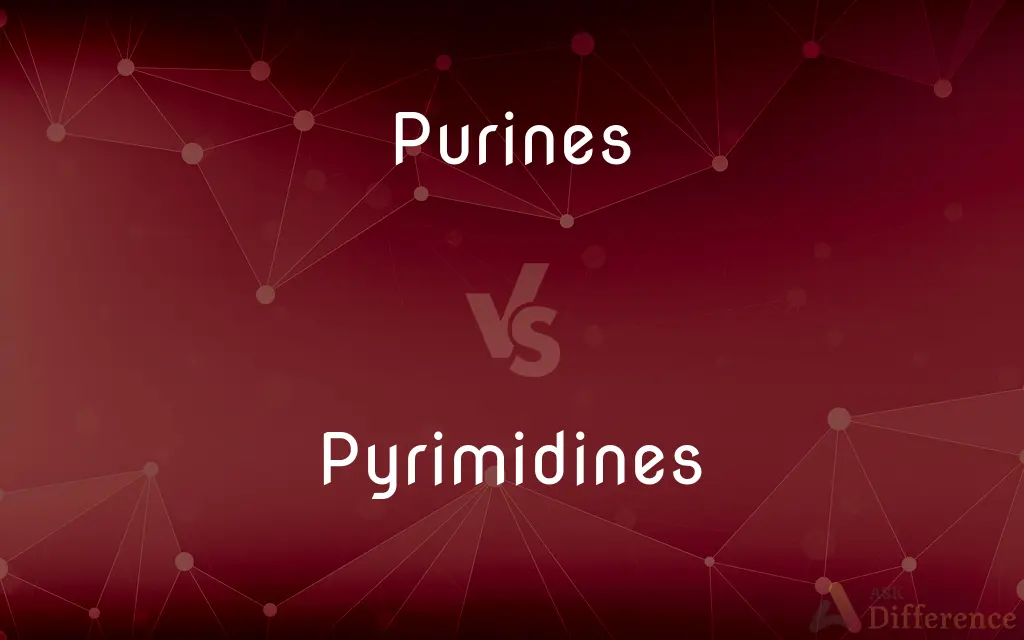Purines vs. Pyrimidines — What's the Difference?
By Tayyaba Rehman — Published on October 11, 2023
Purines are two-ringed nitrogenous bases found in nucleic acids, while Pyrimidines are single-ringed. Both are vital for DNA and RNA structures.

Difference Between Purines and Pyrimidines
Table of Contents
ADVERTISEMENT
Key Differences
Purines and Pyrimidines are essential components in the molecular structure of both DNA and RNA. Purines, which include adenine (A) and guanine (G), are larger structures with a double-ring nitrogenous base. These components are crucial for the coding, decoding, regulation, and expression of genes within a cell.
Pyrimidines, on the other hand, consist of cytosine (C), thymine (T) in DNA, and uracil (U) in RNA. They have a single-ring nitrogenous base. Pyrimidines are equally important in the genetic process, pairing up with Purines to form the DNA ladder. Specifically, adenine pairs with thymine, and guanine pairs with cytosine.
The structural distinction between Purines and Pyrimidines is fundamental to their function. This difference in structure ensures proper pairing in DNA strands and maintains the regularity of the DNA double helix. Without this distinct pairing system between Purines and Pyrimidines, the genetic information would be distorted or lost.
Another essential factor to understand is the metabolic pathways of these compounds. Purines and Pyrimidines are synthesized and degraded through different processes in the body. These pathways are critical as they regulate the amount of each nitrogenous base available for DNA and RNA synthesis.
Comparison Chart
Number of Rings
Double-ringed structure.
Single-ringed structure.
ADVERTISEMENT
Examples
Adenine, Guanine.
Cytosine, Thymine (DNA), Uracil (RNA).
Pairing in DNA
A with T, G with C.
C with G, T with A.
Structural Size
Larger.
Smaller.
Metabolic Pathways
Different synthesis and degradation pathways.
Different synthesis and degradation pathways.
Compare with Definitions
Purines
Components that pair with specific Pyrimidines in DNA.
In DNA, Purines always pair with their complementary Pyrimidines.
Pyrimidines
Nitrogenous bases with a single-ring structure.
Pyrimidines include cytosine and thymine in DNA.
Purines
Synthesized and degraded through specific metabolic pathways.
The body regulates Purines through complex metabolic pathways.
Pyrimidines
Participate in cellular activities and energy conversion.
Some Pyrimidines are involved in carbohydrate metabolism.
Purines
Found in both DNA and RNA structures.
Purines play a role in the formation of both DNA and RNA molecules.
Pyrimidines
Components that pair with specific Purines in DNA.
Pyrimidines ensure correct pairing with Purines in the DNA structure.
Purines
Involved in various biological reactions beyond nucleic acid formation.
Purines are also precursors to several bioactive molecules.
Pyrimidines
Have their synthesis and breakdown pathways.
Disruption in Pyrimidines' metabolic pathways can lead to diseases.
Purines
Nitrogenous bases with a double-ring structure.
Purines like adenine and guanine are essential in DNA.
Pyrimidines
Essential components in DNA and RNA.
Uracil, a Pyrimidine, replaces thymine in RNA.
Purines
A double-ringed, crystalline organic base, C5H4N4, that is the parent compound of a large group of biologically important compounds.
Pyrimidines
A single-ringed, crystalline organic base, C4H4N2, that is the parent compound of a large group of biologically important compounds.
Purines
Any of a group of substituted derivatives of purine, including the nitrogen bases adenine and guanine, which are components of nucleic acids. Uric acid, caffeine, theobromine, and theophylline are also purines.
Pyrimidines
Any of a group of substituted derivatives of pyrimidine, including the nitrogen bases uracil, cytosine, and thymine, which are components of nucleic acids. Barbiturates and certain other drugs are also pyrimidines.
Purines
Plural of purine
Pyrimidines
Plural of pyrimidine
Common Curiosities
What are the examples of Purines?
Adenine and guanine are Purines.
Which Pyrimidine is found only in RNA?
Uracil is a Pyrimidine found only in RNA.
Which Pyrimidines are found in DNA?
Cytosine and thymine are Pyrimidines in DNA.
How do Purines pair with Pyrimidines?
Adenine pairs with thymine, and guanine pairs with cytosine.
Are Purines larger than Pyrimidines?
Yes, Purines have a double-ring structure, making them larger.
Why is the distinction between Purines and Pyrimidines important?
It ensures correct pairing in DNA and maintains the double helix structure.
How do Purines and Pyrimidines impact genetic information?
They store and transmit genetic information in cells.
Is the pairing of Purines and Pyrimidines consistent in DNA?
Yes, adenine always pairs with thymine, and guanine with cytosine.
Are Purines and Pyrimidines found in foods?
Yes, foods like organ meats are high in Purines.
Can DNA function without Purines or Pyrimidines?
No, both are essential for DNA structure and function.
What happens if there's an imbalance between Purines and Pyrimidines?
It can lead to DNA replication errors and potential genetic mutations.
Are there any diseases related to Purines' metabolism?
Yes, gout is a common disease related to Purine metabolism.
Can a high intake of Purines affect health?
Yes, excessive Purines can lead to conditions like gout and kidney stones.
Do Purines and Pyrimidines play roles beyond DNA and RNA?
Yes, they participate in various biological reactions and molecule formations.
How are Purines and Pyrimidines synthesized in the body?
Through specific metabolic pathways that regulate their levels.
Share Your Discovery

Previous Comparison
Naivety vs. Ignorance
Next Comparison
Pine Wood vs. PlywoodAuthor Spotlight
Written by
Tayyaba RehmanTayyaba Rehman is a distinguished writer, currently serving as a primary contributor to askdifference.com. As a researcher in semantics and etymology, Tayyaba's passion for the complexity of languages and their distinctions has found a perfect home on the platform. Tayyaba delves into the intricacies of language, distinguishing between commonly confused words and phrases, thereby providing clarity for readers worldwide.













































